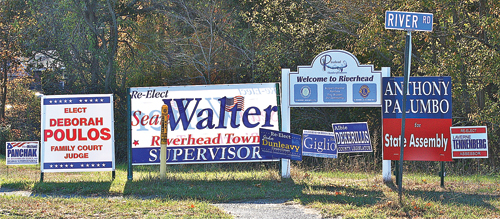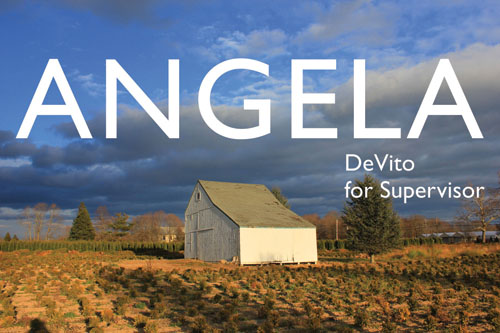Experts break down the science behind the political signs

Political yard signs, says John Galla, are a lot like measles. “You put one down and the next day there’s 14 more,” explained the former Riverhead Republican Committee chairman.
And while their design schemes may seem straightforward enough — a dabble of red, a smattering of blue and the candidate’s name in block letters are all typical features — considerable thought goes into the creation and execution of the average 24-by-18-inch sign.
“Look at what Coca Cola’s done with red and white,” Mr. Galla said, referring to the soda giant’s globally recognizable colors. Mr. Galla has designed Riverhead Supervisor Sean Walter’s political yard signs since 2009. “Consistency always sells in advertising, right?” he asked.
When designing Mr. Walter’s signs, Mr. Galla said, he strives for that same level of consistency. Mr. Walter’s last name, which is prominently featured on all the candidate’s signs, is usually accompanied by a reworked image of the American flag on a white background.
“These are the signs I’ve always had,” Mr. Walter said. “They’re very effective and anybody who tells you they’re not hasn’t run a political race.”

Mr. Walter’s opponent, Democratic nominee Angela DeVito, has taken a very different approach in her campaign. She teamed up recently with Aquebogue artist Cliff Baldwin to create 35 full-color signs featuring photos of seven different North Fork vistas. Instead of promoting her last name the way Mr. Walter’s signs do, Ms. DeVito’s first name is front and center.
“That was a deliberate decision,” Ms. DeVito said. “When people go to vote, they don’t see DeVito, Angela. They see Angela DeVito. It’s also to put out the fact that I’m a very approachable individual. I don’t stand on a lot of formality.”
What works best? In the 25 years he’s worked at Wedel Signs on West Main Street in Riverhead, designer Ted Squires said that when it comes to the efficacy of political signs, simplicity is key.
“As far as the wording goes, keep it simple,” he suggests. “Include your name, what you’re running for and either ‘elect’ or ‘re-elect.’ The more you put on [the sign], the less people will read.”
While it remains to be seen which candidate will prevail at the polls — and, ostensibly, whether or not their placards could be judged effective or not — political yard signs have had a place in American history since the years immediately following World War II, said Stanley Klein, professor of political science at C.W. Post Long Island University in Brookville.
The reason, Mr. Klein said, is simple: more Americans owned houses with lawns after the war.
And political yard signs do work, he said, although he considers door-to-door stumping for votes a candidate’s best shot of getting elected.
“In Nassau County during the 1968 election, there was an assemblyman running by the name of Marty Ginsberg,” Mr. Klein said. “He had 45 four-by-eight signs put up around his election district. Newsday’s comment [at the time] was, ‘It is no longer Plainview. It is Ginsberg-ville.’ By the way, he was re-elected.”
More than 40 years later, candidates are still banking on the hope that a purposefully positioned yard sign might make the difference between victory and defeat.
“I really put [the signs] out there to remind people of this election,” Ms. DeVito said. “I would say it’s 50/50 that people will get the message.”


